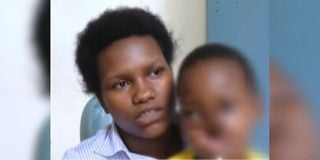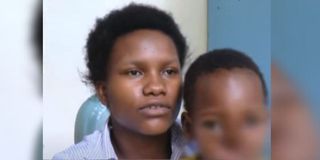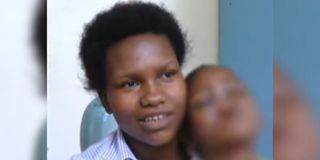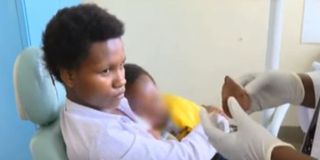Premium
Boy whose face was disfigured by a bandit’s bullet hopes to smile again

Bessy Kinya with her six-year-old, Ian Baraka, at Kenyatta National Hospital.
What you need to know:
- Two months ago, Baraka would have been among learners joining Grade One.
- But instead, he is in another class — learning to walk again, swallow and talk.
Three days to Christmas, on December 22 last year, Bessy Kinya left her home in Latuani village and headed to the neighbouring Mutuati market, both in Meru County.
Bustling with holiday cheer, she planned to buy new clothes and festive food for her two children, just like most families here did.
She left the children at home playing, entrusting their care to their father and grandmother. But when she returned home that evening she was met by a crowd milling around the homestead.
“I saw the police officers first before my eyes settled on the sickening pattern of blood spatter on the ground. Villagers were huddled together, their eyes wide with a mixture of fear and something else I couldn't decipher. I asked what had happened but everyone coiled away,” she recalls.
What she didn’t know at the time was that bandits had attacked her homestead and stolen cows and goats. During the raid, the attackers had also shot at her six-year-old firstborn son, Ian Baraka.
The bullet ripped through his face, entering through the lower side of his jaw and exiting slightly above his cheek.
That was the scene that Kinya had walked into that bleak evening.
Ms Kinya had left a sprightly young boy playing at home in the morning, and now she had come back to the macabre scene of that same young man disfigured by a bandit’s bullet.
In her words, Latuani village was always known for its perpetual state of slumber. It was the kind of village where nothing much happened, a small hamlet so distant, so reclusive that it appeared to have warded off the chaotic pursuits of the modern era.
When Ms Kinya married into this village from the neighbouring one five years ago at the age of 21, she was met with stories of despair and struggle.
Villagers spoke of bandits preying on those who ventured to graze far from the village, but those stories were too abstract for her to comprehend.
She could understand bandit attacks, but, in her innocence, couldn’t place the anger and anguish they caused within Latuani.
They were too far. Too foreign.
The location of her home borders Isiolo County to the north, where cases of banditry are rife.

Bessy Kinya with her six-year-old, Ian Baraka, at Kenyatta National Hospital.
Just last week, three people were killed in Mulango village by bandits suspected to have crossed over from the neighbouring Samburu County.
The attackers stole over 200 cattle, sparking protests in Isiolo town. A similar attack in February claimed two lives.
This recent spate of violence is just the latest chapter in a long and tragic saga of cattle rustling and inter-communal clashes that have plagued the region for years.
Some parts of Igembe North experience prolonged drought cycles and reduced yields and have supplemented farming with pastoralism.
And that is causing a lot of trouble here.
“I can remember times when villagers lost animals while out grazing,” says Kinya. “In those moments, I'd reassure myself that as long as the herds were back safe, nothing would happen at home.”
Until it did. In the worst way conceivable.
“It was a miracle that he survived,” she says.
And she is right.
In the dental examination room at Kenyatta National Hospital (KNH) in Nairobi, Baraka is clutching a box of coloured pencils in one hand.
He plucks a random colour and wobbly reaches for the open colouring book in front of him. Across from him, his mother, wrapped in a shawl, watches him with weary eyes.

Bessy Kinya with her six-year-old, Ian Baraka, at Kenyatta National Hospital.
When he struggles to make some drawings, she fidgets and looks the other way.
Two months ago, Baraka would have been one of the many learners joining Grade One in Latuani village.
But instead of being in class learning about numbers, he is in another class — learning to walk again, swallow and talk.
He is a baby once again, the trajectory and milestones of his life altered by the callous bandits who struck his home.
“It took me two whole weeks to recover from the shock,” says Kinya.
“I couldn’t even summon the strength to go see him at Meru Level Five Hospital, where he was first admitted before we were transferred here. The first day I saw him, I cried my heart out.”
Dr Andrew Okiriamu, an oral and maxillofacial surgeon at KHN, says Baraka was shot through the mandible and the bullet exited through the mid-face.
The mandible is the largest bone in the human skull, forming the lower jawline and shaping the contour of the inferior third of the face.
It supports the bottom row of teeth and gives shape to the lower face and chin. It is the bone that moves as the mouth opens and closes.
The upper jaw, known scientifically as the maxilla, holds the upper teeth, shapes the middle of the face, and supports the nose.
As the bullet tore through Baraka’s face, it shattered his lower jaw, part of his face, tore off his upper lip, shattered his upper jaw, and ripped through part of his nose.
Since his admission two months ago, he has received extensive rehabilitation.
“He came to us intubated and was immediately taken to the intensive care unit for care,” says Dr Okiriamu.
“He has gone to theatre at least once and we have managed other issues, such as periorbital infections, and stabilised his lower jaw to a point where healing has taken place there.
"What we are left with is the mid face injuries and the missing top tissue – the upper lip and part of his nose. He is missing most of his upper jaw and nasal bones and the palate, which refers to the roof of the mouth.”
Dr Okiriamu has attended to many patients in his life, but he says this is one of the most extensive injuries he has ever seen in a child.
“When we started to observe him, he couldn’t move a lot and was grossly emancipated. He couldn’t take anything orally, but through rehabilitation we have been able to take him from feeding tubes and he is now learning how to swallow.
"As he presented trouble walking, the hospital has put him through aggressive physiotherapy and he is walking, albeit with a bit of struggle. His vision was also affected,” says the doctor.

A medic attends to six-year-old, Ian Baraka, at Kenyatta National Hospital.
While facial reconstruction is possible in adults, it is not possible to do it on Baraka using his own tissues because he is too young.
Doctors, therefore, have opted to allow him time to grow before they can consider any reconstructive surgery.
Some of the options they are considering are patient-specific implants and facial prostheses to cover the defects. This, they believe, should allow Baraka the freedom to feed and grow.
“We need a patient-speficic implant that takes into account the growth area so that the face can continue to grow,” says Dr Margaret Mwasha, a maxillofacial prosthodontist at the hospital.
The prosthetics will enable him to speak better, swallow and partition the mouth and nose tissues.
In the interim, the team of doctors has fabricated silicone prostheses to cover the openings.
“We took measurements from him to cover the disfigurement. But there is no bone to support it so we are forced to use adhesive to cover it as a temporary solution,” says Dr Mwasha.
To help Baraka recover and go back to his normal life, the doctors propose using transplants made of titanium as the metal is biocompatible with human tissue. However, the technology is not available in Kenya yet.
“We have engaged clinical engineers in Belgium and the quote that we are receiving is about Sh2 million, which the family cannot afford. We require two pieces that they have to keep changing between six months to a year,” she says.
Due to the extent of the injuries and the treatment procedures involved, Dr Mwasha says they are looking at periodic follow-up until Baraka is about 16 years old.
For now, the young boy was life was shattered most brutally lies at Kenyatta National Hospital. His mother, drained by this tragedy, is by his side every day, hoping against hope that her son will rise from this catastrophe.





